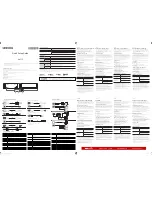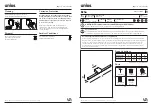
RITE-HITE VBR-300 DOK-LOK Owner’s Manual
5
Definition and Function
The VBR-300
DOK-LOK
vehicle restraint is a hydraulic,
ground stored restraint device used to secure trucks and semi-
trailers with an intact Rear Impact Guard (R.I.G.) to the face of
a loading dock. This is achieved by securing the R.I.G. with a
hydraulically powered steel barrier. This prevents forward
movement of the truck/trailer that may create an unsafe void
between the face of the dock and the rear end of the truck/
trailer as a forklift travels from the loading dock onto the trailer;
or to create an obstruction noticeable to the truck driver, should
the driver accidentally try to pull the truck/trailer away while it is
being serviced.
The proper or improper activation of the barrier is monitored
by:
• VISUAL CONTROL
— One set of flashing green or red lights located at the
inside of the building for the forklift operator, and one
set located outside of the building for the truck driver. In
addition to the lights, there are three instruction signs.
• AUDIO CONTROL
— A horn will sound at the inside of the building, warning
the forklift operator if there is no R.I.G. present, or if the
engagement is improper. In this case, the trailer must
be secured by other means (wheel chocks, etc.) prior to
servicing trailer.
Prerequisite for proper barrier engagement is that the trailer is
parked firmly against a 4" (trade standard) thick dock bumper.
The activation/deactivation is solely controlled from the inside
of the building by momentarily depressing either the Lock
(raise) button or the Unlock (lower) button.
The normal mode of the barrier is in the lower STORED
position, showing a flashing red light (trailer not secured) at the
inside of the building and a flashing green light (trailer free to
move to or away from the loading dock) at the outside of the
building.
Once the trailer is parked, the dock attendant will depress the
Lock button. This will raise the barrier to engage the R.I.G. As
soon as the R.I.G. is properly locked, there will be
simultaneous light change — the inside will change from red to
green flashing (trailer secured) and the outside will change
from green to red flashing (do not move trailer). After the
service is completed, the dock attendant will have to depress
the Unlock button which then will return the barrier to its lower
STORED position.
A proper barrier engagement is achieved when the barrier
raises unobstructed to secure the horizontal cross member of
the R.I.G. Assembly. An improper barrier engagement is if the
horizontal cross member of the R.I.G. is missing, obstructed or
it is bent or located so far toward the rear axle of the trailer that
it will prevent the free passage of the barrier. In either case, the
lights will stay in a non-serviceable mode and a horn will
sound. At this point, the trailer must be secured by other means
(example: wheel chocks) in order to become serviceable.
Features
Refer to
Figure 2, page 6
for the locations of the following
features:
R.I.G.
Acronym used for the Federally mandated
rear impact
guard
located on the rear of over the road trailers to
prevent accidental underride by automobiles.
Roller Track Assembly
Mounted to the loading dock wall to guide the barrier
assembly in a vertical plane and transmit the creep or pull
out force from a trailer to the loading dock wall.
Barrier Roller Assembly
Comprised of a steel roller housing, a pre-lubricated
needle bearing to allow easy movement of the barrier
assembly.
Float Mechanism
Allows barrier to move downward once engaged to
maintain contact with the R.I.G. while servicing a trailer.
R.I.G. Sensor
Detects when the barrier is secured to the R.I.G.
Barrier Assembly
Secures R.I.G. to prevent trailer from rolling/creeping away
from the dock.
Hydraulic Assembly
Provides means of moving the barrier between its stored
and active positions.
Base Cover
Protects the barrier assembly, float mechanism, hydraulic
hoses and lift cylinder from debris.
Track Cover with Integral Lip Guide
Keeps debris out of the roller track. Integral lip guide is
used to guide the lip past the roller track assembly in a
below dock end load condition.
Sensing Switches, Control Box, Outside Light Box and
Signage
Combination of these components is used to control the
VBR-300
DOK-LOK
vehicle restraint and provide audio/
visual communications to the dock attendant and trailer
driver.






































